Uncovering the Beauty of Belize
Beyond its breathtaking scenery, discover why this Central American country is an oasis for ecotourism
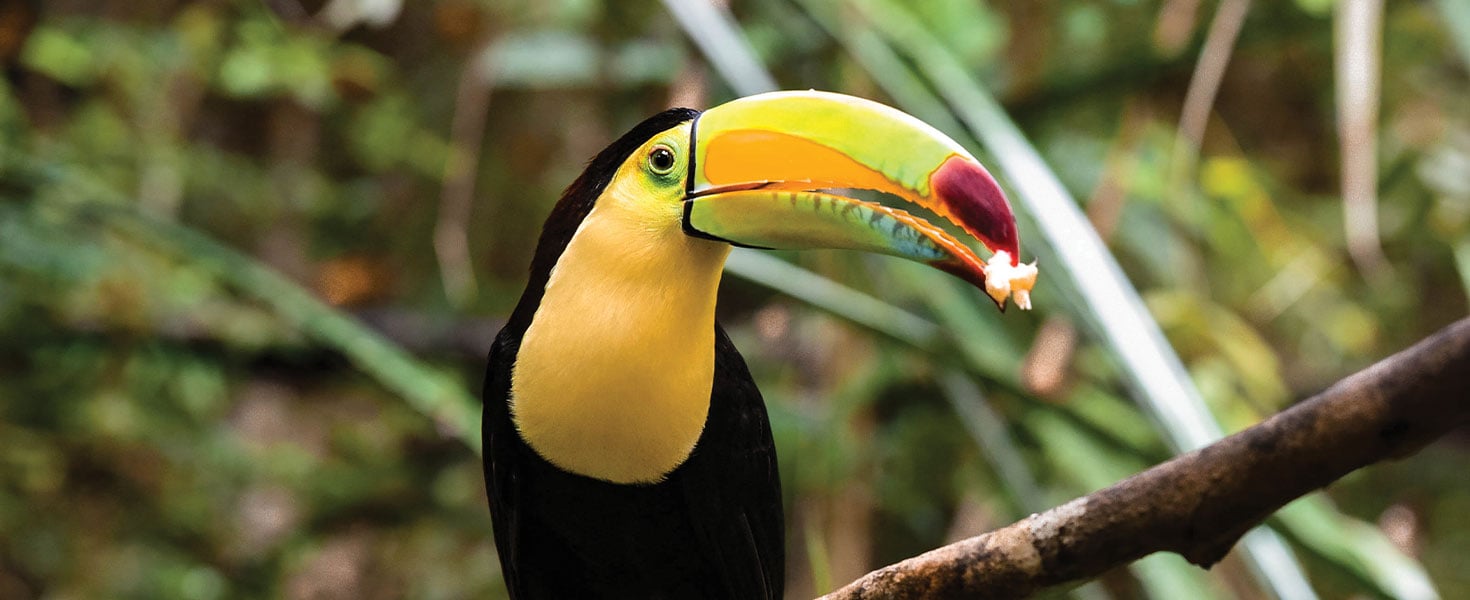
Our SUV lumbers over the rocky dirt roads, dipping into ruts forged by rainforest runoff. “We call this a Belizean massage,” jokes our driver, Abias. After a 90-minute drive from Belize City Airport, we arrive at Mystic River Resort, just outside San Ignacio and Santa Elena, twin cities near the border with Guatemala.
For the next four days, my husband, Steve, and I settle into a cottage that sits high on a ridge overlooking the Macal River, which snakes between densely forested mountains.
According to the resort’s manager, Petro Steunenberg, conservation and working with nature is priority one here. Mystic River collects and purifies its own water, generates its own electricity, and regularly replants indigenous mahogany and rosewood trees, she says. While there is no air conditioning, Wi-Fi or television—and we don’t miss it—the resort feels indulgent. The sun and vibrant bird chatter in the treetops wake us each morning. Sitting on our deck, we shake off our slumber with some caffeine and the entertainment of toucans, black-headed trogons, blue-diademed motmots and olive-throated parakeets.
Ecotourism—or responsible, sustainable travel through experiential learning and exploration—is the heart of Belize’s tourism industry, and it’s in part what drew us to this friendly English-speaking country. We were equally attracted to the rich cultures here, which include Maya, Creole, Mestizo, Indian, Garifuna and even Mennonite, and the opportunity to learn about their histories and traditions.
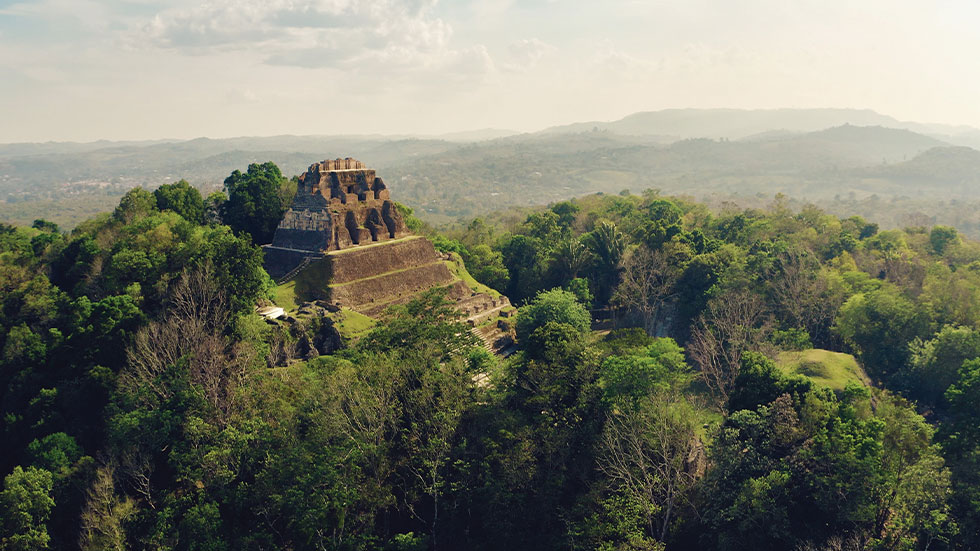 El Castillo is the central temple of the Maya ruins at Xunantunich; Photo courtesy of The Belize Tourism Board
El Castillo is the central temple of the Maya ruins at Xunantunich; Photo courtesy of The Belize Tourism Board
ANCIENT RUINS
There’s no better way to start our exploration than with a deep dive into Maya culture, so we head just outside San Ignacio to the ruins of Xunantunich, just one of more than 600 Maya sites identified and in various states of excavation across Belize. Xunantunich still puzzles archaeologists because research indicates the city was ascending to prominence around AD 700 to 1000, just as other Maya cities were collapsing across Central America.
We access Xunantunich via a hand-cranked ferry across the Mopan River. Gravel crunches under our feet as we climb a hill to the plateau of this massive former city. As we walk, our guide, Darryl, points out local flora and fauna and shares bits of information about the ancient Maya. He directs our attention, for example, to the ceiba tree. One of the largest tree species in the American tropics, the ceiba was especially significant to the Maya, who believed that the tree’s roots connected this world to the underworld.
We climb what feels like a hundred steps to the top of El Castillo, the 130-foot-tall limestone temple at the city’s center. The steps are steep and slippery, and there’s nary a railing in sight. At the top, I feel a touch of vertigo as I take in the vast Guatemalan jungle before me. I imagine great priests or kings addressing the estimated 200,000 residents of Xunantunich—about two-thirds the size of Belize’s population today.
Prehistoric-looking iguanas on stone outcroppings appear as if they’re standing guard, like relics of the lost city.
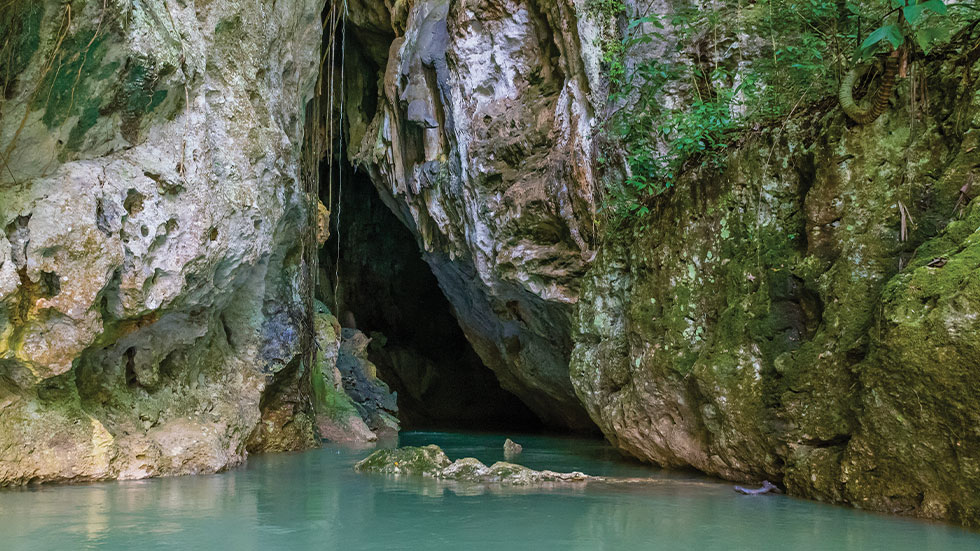 Barton Creek Cave, one of Belize’s most popular ecotourism attractions: cave entrance; Photo by John/stock.adobe.com
Barton Creek Cave, one of Belize’s most popular ecotourism attractions: cave entrance; Photo by John/stock.adobe.com
GEOLOGICAL WONDERS
The jungle is a geologist’s dream. There are more than 100 limestone caves to explore in Belize, and Abias—our driver from the first day, whom we have hired to take us around—suggests that we visit one. We go to spring-fed Barton Creek Cave—one of the longest and most impressive subterranean landscapes in the country—which was discovered in 1970 by members of the Peace Corps.
Just a short drive from San Ignacio, this cave system is accessible only by canoe and with an experienced guide. Long ropey vines obscure the main entrance, leaving just a small opening to paddle through. Inside, Abias tells us to turn on our headlamps, which create flame-like reflections along the cave walls. When we tilt our heads back, our lamps illuminate massive limestone stalactite formations twisting down from the apex of the cave like ribbons that are 100 feet long in some places. At times, the formations extend so close to the water’s surface that we must lie flat to pass underneath.
About a mile into the cave, we can go no farther. Abias asks us to turn off our headlamps. We can see nothing in the darkness, yet it’s surprisingly peaceful.
We are quietly thoughtful as we paddle back to the entrance of the cave. We enjoy a quick refreshing dip in the crisp, bright-blue water of Barton Creek, marveling at what we’ve seen.
STEWARDING THE FUTURE
We spend the afternoon at Green Hills Butterfly Ranch, a 250-acre property in the rainforest dedicated to conservation and education. The butterfly enclosure, the main attraction, stops us in our tracks as we take in the thousands of butterflies swirling around us: electric blue morphos, malachites and glass wings—more than 30 species in all. They hitch rides on our clothing as we stroll the lush garden trails, careful not to step on any butterflies resting on the path.
The workers lovingly tend to the hundreds of chrysalides dangling from chicken-wire frames and refill nectar feeders and banana trays. They answer our questions about the different species and talk to us about the essential role of pollinators in the ecosystem.
Equally important in their role as pollinators and not to be outdone by the showy butterflies, the hummingbirds—as many as 15 native species—provide endless entertainment at nectar feeders outside a small pavilion. The tiny birds whip about our heads, oblivious to our presence, creating a thrumming sound as they bicker and dive-bomb in territorial wars. We watch the exhilarating show—a fitting finale to our time in the jungle—before heading back to Belize City and on to the cayes.
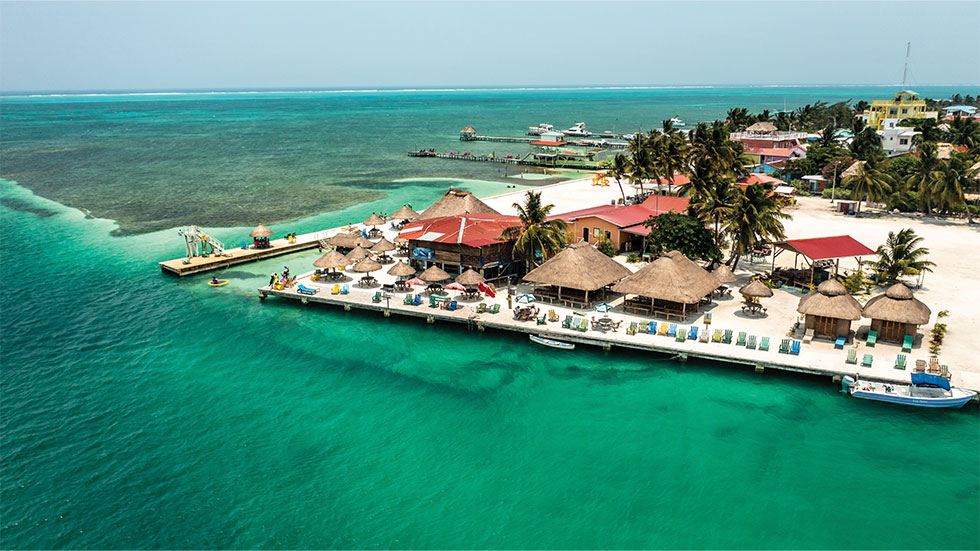 Visitors to Caye Caulker enjoy snorkeling, swimming and socializing; Photo courtesy of The Belize Tourism Board
Visitors to Caye Caulker enjoy snorkeling, swimming and socializing; Photo courtesy of The Belize Tourism Board
SEAS AND CAYES
At 25 miles long and 1 mile wide, Ambergris Caye is the largest and most heavily visited of more than 450 cayes along Belize’s coast. Its town center, San Pedro, is a high-energy blend of eclectic shops, multicultural cuisine, powdery beaches and golf carts that zip through the town’s narrow, unpaved streets. It is also the gateway to Hol Chan Marine Reserve’s four protected marine habitat areas: mangrove, sea grass, reef and shark ray alley. Belize boasts the world’s second-largest barrier reef and the Blue Hole, a massive marine sinkhole measuring nearly 1,000 feet across and 350 feet deep (both UNESCO World Heritage Sites), so it’s no surprise that the country is a global destination for marine ecotourism and recreational diving.
Many excursions embark from Caye Caulker, a 5-mile-long coral island just a 30-minute ferry ride from Ambergris. With a laid-back vibe that attracts surfers and scuba divers, it’s a perfect spot from which to explore Hol Chan Marine Reserve and then unwind after a day in the sun.
We sip our morning coffee in silence and watch as dolphins wake-ride alongside the ferry. Caye Caulker is restricted to pedestrians only, so Steve and I walk the short distance from the dock to Salt Life Ecotours, where we meet Renee, our guide for the afternoon. He gives us the lowdown on the day ahead.
Our first stop is shark ray alley. Rays, turtles and 10-foot-long nurse sharks surround our boat, a habit reinforced by fishermen who once cleaned their catch here after a day’s work. The sea life is nonaggressive, and we snorkel among these giant creatures, occasionally receiving a nudge from a fin as they swim past.
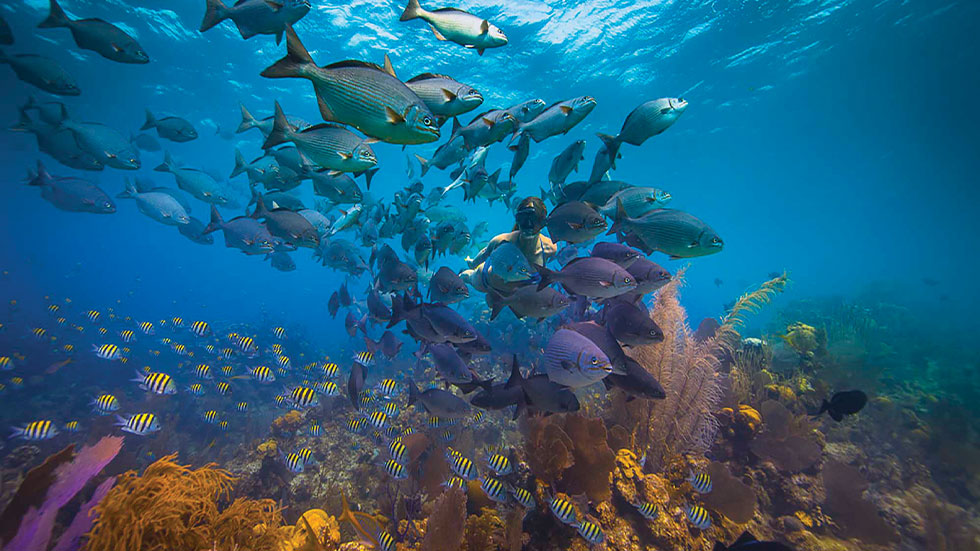 A diver’s view in Belize; Photo courtesy of The Belize Tourism Board
A diver’s view in Belize; Photo courtesy of The Belize Tourism Board
We snorkel at various spots along the reef, and Renee points out different species of coral, green sea turtles, angelfish, parrotfish and eagle rays. There has been great success in southern Belize propagating elkhorn and staghorn coral, he explains, and this has prompted action by the San Pedro Tour Operators Association to follow suit, with tour operators trained to plant coral and monitor the health of the reef.
We’re back in the boat again when Renee shuts down the engine and allows us to drift into the sea grass, where a manatee cow and her calf, protected under Belizean law, graze peacefully along the bottom. Renee waits, the boat bobbing on the gentle waves, until the manatees move off. Only then does he push out of the grass with a long pole to find deeper water, ensuring that he doesn’t frighten or harm the manatees when he starts the engine.
It’s been a long day of sun, and after returning to the dock, Steve and I relax by exploring Caye Caulker. Music wafts down from The Lazy Lizard, a popular venue for music and libations, but we continue past. We are seeking out Chef Kareem’s UnBelizeable Lunch, a little beach-front food truck that’s a must-do for fresh grilled lobster, we’ve been told. We watch Chef Kareem grill our lobster and plantains and top them off with rice and beans, and we notice that he’s always smiling. As we sit watching the sunset, eating this amazing meal on the beach, we understand why.
